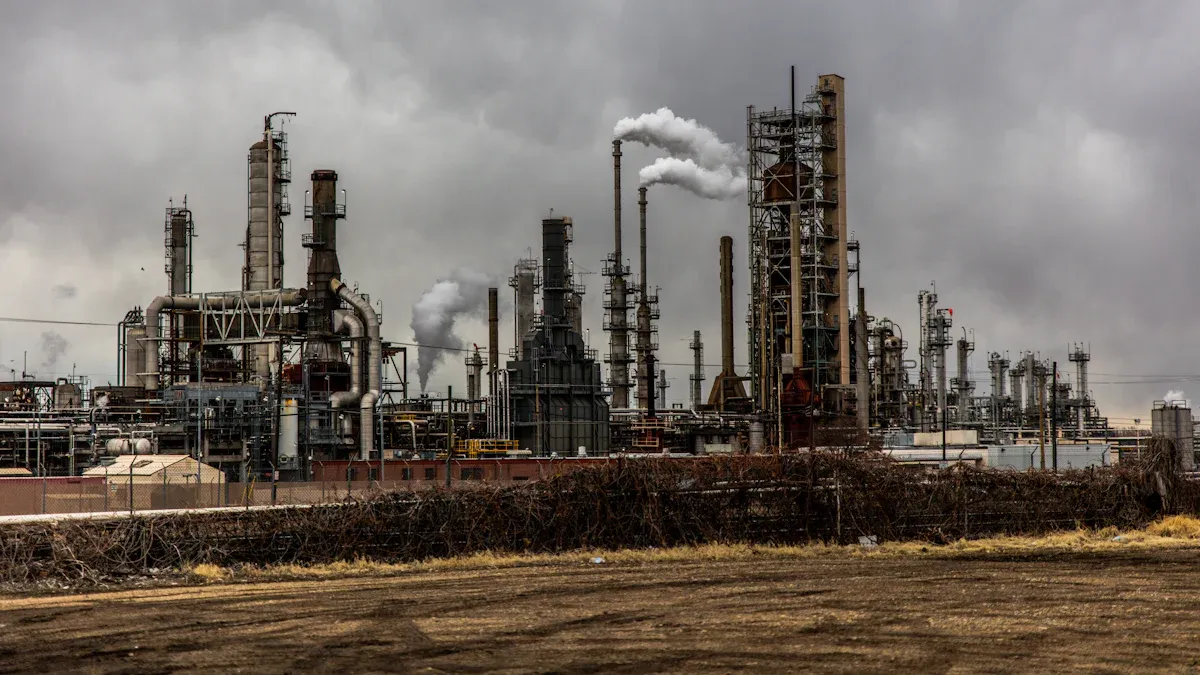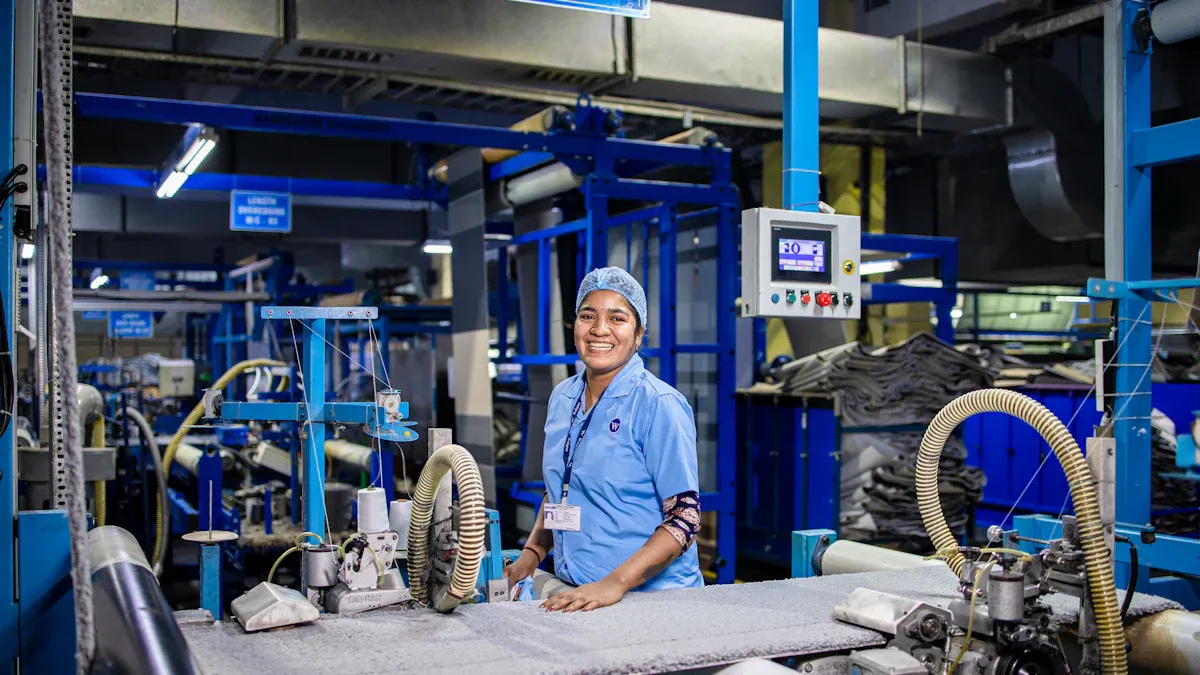
News

Imagine a world where manufacturing processes are faster, safer, and more precise, thanks to induction heating systems. These Induction Heating Systems provide uniform heating, reduce labor costs, and enhance productivity. Industries like automotive and aerospace have embraced induction for its efficiency and versatility, including the use of Induction Heating Machine Coating Removal Systems. With global adoption growing, the future looks even brighter.
Key Takeaways
Induction heating systems make manufacturing quicker, safer, and more accurate.
They are 84% energy efficient, cutting costs and saving time.
Using induction heating is safer since it removes open flames.
This lowers the chance of accidents at work.
What Are Induction Heating Systems?
How Induction Heating Works
Induction heating is a fascinating process that uses electromagnetic induction to heat conductive materials. Here’s how it works: an alternating current (AC) flows through an induction coil, creating a magnetic field. When you place a conductive material, like metal, inside this field, it generates eddy currents. These currents heat the material due to electrical resistance.
Think of it like this: the induction coil acts as a powerful magnet, and the metal workpiece becomes the target. The heat is generated directly within the material, making the process incredibly efficient. This method eliminates the need for physical contact or open flames, which is why it’s so popular in industries like automotive and aerospace.
Here’s a simplified diagram of the induction heating process:
AC Power Supply → Generates alternating current.
Induction Coil → Produces the magnetic field.
Workpiece → Absorbs heat through eddy currents.
Key Features of Induction Heating Technology
Induction heating technology stands out for its speed, precision, and safety. It can heat materials to 1,000°C in less than a second, making it one of the fastest heating methods available. The design of induction heating equipment allows you to target specific areas with customizable coils, ensuring precise temperature control.
Here’s how it compares to other heating methods:84%
Induction furnace technology also offers a cleaner and safer alternative. It doesn’t rely on gas or open flames, reducing the risk of accidents and keeping the workspace cooler. Plus, the integration of smart technologies and IoT has made induction heating equipment even more efficient.
With a global market size of $1.9 billion in 2023 and a projected growth to $3.4 billion by 2030, it’s clear that induction heating systems are shaping the future of manufacturing.
Benefits of Induction Heating Systems

Improved Efficiency and Precision
When it comes to manufacturing, efficiency and precision are everything. Induction heating systems excel in both areas. These systems transfer energy directly to the material, achieving an impressive energy efficiency of 84%. Compare that to gas burners, which only reach 40%, and you’ll see why industries are making the switch.
Induction heating doesn’t just save energy—it also speeds up production processes. For example, one plant reduced its heating time from 70 minutes to just 45 seconds. That’s a game-changer for productivity. Plus, the precision of induction heating ensures consistent results. Whether you’re working on induction hardening for tools or welding delicate components, you can trust the process to deliver high-quality outcomes every time.
Did you know? Induction heating supports the production of high-performance firearms and ammunition by enhancing component durability and meeting strict industry standards.
Cost Savings and Reduced Downtime
Induction heating systems are not just efficient—they’re cost-effective too. By integrating seamlessly into automated production processes, they reduce labor costs and improve productivity. One customer reported cutting annual operating costs from over $10,000 to just $1,000 after switching to induction furnace technology.
Downtime is another major expense in manufacturing. Induction heating minimizes this by drastically reducing heating times. Imagine going from 70 minutes to 45 seconds—that’s a 50% reduction in downtime! With faster heating, operators can focus on other tasks, boosting overall productivity. And because induction systems don’t rely on open flames, they lower the risk of accidents, saving you money on potential safety incidents.
Enhanced Safety and Environmental Benefits
Safety and sustainability are top priorities in modern manufacturing. Induction heating eliminates combustion, reducing the risk of gas leaks and making your workspace safer. The absence of open flames also keeps the environment cooler, creating a more comfortable setting for your team.
From an environmental perspective, induction heating shines. It uses pre-set programs and closed-loop temperature control to ensure consistent quality without wasting energy. This not only enhances production processes but also reduces your carbon footprint. Plus, induction furnace technology is easy to operate, so you don’t have to rely heavily on skilled labor to maintain high standards.
Pro Tip: Switching to induction heating can help your company meet environmental regulations while improving safety and productivity.
Success Stories in the Induction Heating Industry
Automotive Industry: Faster and Cleaner Heat Treatment
The automotive industry has embraced induction heating for its speed and precision. You can now achieve faster heat treatment with minimal variability. Induction hardening ensures consistent hardness profiles, improving the durability of components like gears and crankshafts. Operators no longer need to worry about inconsistencies caused by manual processes.
Here’s how induction heating stands out:
This technology also reduces cycle times, increasing production speed by 20%. Plus, it’s cleaner and safer, eliminating the need for open flames or gas burners.
Electronics Manufacturing: Precision Heating for Delicate Components
In electronics, precision is everything. Induction heating allows you to heat specific areas of delicate components without damaging surrounding materials. For example, it’s used to preheat PCBs, ensuring uniform temperatures and preventing cold solder joints.
Key benefits include:
Localized heating for targeted applications.
Enhanced material performance, improving reliability.
Rapid heating and cooling, reducing cycle times.
This process minimizes energy loss, making it both efficient and cost-effective.
Aerospace Industry: High-Performance Material Processing
The aerospace industry relies on induction heating for high-performance material processing. You can achieve precise temperature control, which is critical for components like turbine blades. Induction hardening enhances wear resistance and fatigue strength, ensuring these parts withstand extreme conditions.
By using induction furnace technology, aerospace manufacturers have reduced energy consumption by 30% while maintaining top-notch quality.
Steel Industry: Enhanced Production with Induction Furnaces
Steel production has seen remarkable improvements with induction furnace technology. These furnaces offer energy transfer efficiency of 84%, compared to just 40% for gas burners. This efficiency translates to significant cost savings and reduced environmental impact.
Induction furnaces also allow for precise control over the steel-making process. You can achieve consistent results, whether you’re hardening tools or producing high-quality alloys.
Pipeline Maintenance: Consistent Heating with RDA Induction Solutions
Pipeline maintenance often requires consistent heating for welding and repairs. Induction heating solutions provide uniform heat distribution, ensuring strong and reliable welds. This method reduces energy costs and speeds up the welding process, making it a preferred choice for industries worldwide.
Heating Industry: Combining 3D Printing and Induction Heating for Efficiency
The integration of 3D printing in the induction heating sector has revolutionized the design of induction coils. Companies like ThyssenKrupp Presta Schönebeck have achieved significant savings by using 3D-printed coils. This innovation enhances efficiency and reduces tooling costs, paving the way for more sustainable manufacturing practices.
Pro Tip: Combining 3D printing with induction heating can optimize your production process and lower operational costs.
Overcoming Challenges in the Induction Heating Process
Initial Costs and ROI Considerations
Switching to induction heating systems can feel like a big leap, especially when you consider the upfront costs. The equipment itself often requires a higher initial investment compared to traditional methods like gas burners. However, the long-term benefits make it worth considering. Energy savings, reduced downtime, and improved efficiency all contribute to a strong return on investment (ROI).
To make the most of your investment, start with a comprehensive cost analysis. Look at factors like production volumes, energy costs, and potential savings. Collaborating with equipment suppliers can also help you understand the financial impact. Many companies even conduct pilot studies to test the waters before fully committing. This approach ensures you’re making an informed decision that aligns with your manufacturing goals.
Tip: While the initial costs may seem steep, the energy efficiency and operational savings of induction heating often pay off in the long run.
Training and Workforce Adaptation
Introducing new technology means your team needs to adapt. Induction heating systems require specialized knowledge, especially when it comes to operating and maintaining the equipment. Training programs are essential to ensure your workforce feels confident and capable.
Start by identifying key team members who will oversee the induction heating process. Provide hands-on training sessions and access to resources like manuals or online tutorials. Many equipment suppliers offer training as part of their service, so take advantage of this support. A well-trained team not only ensures smooth operations but also maximizes the benefits of your investment.
Pro Tip: Encourage your team to embrace the change by highlighting how induction heating simplifies tasks like welding and hardening, making their jobs easier and safer.
Integration with Existing Systems
Integrating induction heating systems into your current manufacturing processes can be challenging, but it’s not impossible. The key is to plan carefully and work with experienced professionals. Many companies take a phased approach, starting with one production line before scaling up. This minimizes disruptions and allows you to fine-tune the process.
Here’s a quick look at successful integration examples:
By focusing on proper planning and collaboration, you can seamlessly integrate induction heating into your operations. This ensures you enjoy the benefits of improved efficiency, precision, and safety without compromising your existing workflows.
Induction heating systems have reshaped manufacturing with their speed, precision, and efficiency. Industries like steel production, aerospace, and food processing benefit from reduced energy use and enhanced safety. Looking ahead, the market is set to grow, driven by demand for sustainable solutions. You’ll see these systems powering innovation across sectors.
Fun Fact: The steel industry alone has cut energy consumption by 30% using induction heating, meeting decarbonization goals.
FAQ
What industries benefit the most from induction heating systems?
Induction heating systems are widely used in industries like automotive, aerospace, electronics, and steel manufacturing. They improve efficiency, precision, and safety across these sectors.
How does induction heating save energy compared to traditional methods?
Induction heating transfers energy directly to materials, achieving up to 84% efficiency. Traditional methods like gas burners waste energy, making induction heating a more sustainable choice.
Tip: Switching to induction heating can significantly reduce your energy bills while boosting productivity.
Can induction heating systems handle delicate materials?
Yes! Induction heating offers precise temperature control, making it ideal for delicate components like PCBs in electronics or turbine blades in aerospace applications.
Fun Fact: Induction heating can heat materials to 1,000°C in under a second!
Please give us a message